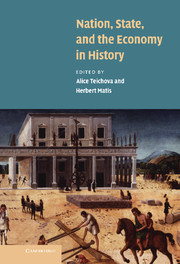Book contents
- Frontmatter
- Contents
- List of figures
- List of tables
- List of contributors
- Acknowledgements
- Introduction
- PART I
- PART II
- PART III
- PART IV
- PART V
- 18 The state and economic growth in Latin America: Brazil and Mexico, nineteenth and early twentieth centuries
- 19 Building the Brazilian nation-state: from colony to globalisation
- 20 The role of nationhood in the economic development of the USA
- 21 Economic policy and Australian state building: from labourist-protectionism to globalisation
- Index
18 - The state and economic growth in Latin America: Brazil and Mexico, nineteenth and early twentieth centuries
Published online by Cambridge University Press: 07 September 2009
- Frontmatter
- Contents
- List of figures
- List of tables
- List of contributors
- Acknowledgements
- Introduction
- PART I
- PART II
- PART III
- PART IV
- PART V
- 18 The state and economic growth in Latin America: Brazil and Mexico, nineteenth and early twentieth centuries
- 19 Building the Brazilian nation-state: from colony to globalisation
- 20 The role of nationhood in the economic development of the USA
- 21 Economic policy and Australian state building: from labourist-protectionism to globalisation
- Index
Summary
If one were looking for historical evidence to support a liberal economic policy, Brazil and Mexico in the period of 1870–1910 would seem to be good cases. During these four decades Latin America's two most populous countries experienced a deepening of capitalist market relations and substantial economic growth while being guided by liberal statesmen who largely believed in the advantages of laissez-faire policies, particularly free trade and foreign investment. Indeed, according to numerous historians, this was the period of economic ‘take-off’ in the two nations. Conventional wisdom holds that in both cases a fundamental cause lay in dismantling the remnants of colonial mercantilist patrimonial regimes by reducing state intervention.
This chapter will take a different stance by arguing that from the 1870s the states in Brazil and Mexico, guided by pragmatic considerations, in fact played substantial and growing roles in forging economic growth and indeed in creating propitious market conditions for domestic and foreign entrepreneurs. Export-led growth in the private sector contributed to the economic transformation of both countries but equally important were active state roles in securing property values, reducing transaction costs through the adoption of new financial and monetary policies and spurring growth of key economic sectors by promotion of state enterprises.
By 1910 governments in these two nations exercised large roles in the export commodity and currency markets as well as in banking, railways and ports.
- Type
- Chapter
- Information
- Nation, State and the Economy in History , pp. 349 - 372Publisher: Cambridge University PressPrint publication year: 2003
- 4
- Cited by

